When I was researching trips to Antarctica, I found some of the more nitty gritty practical stuff that I really I wanted to know, seemed conspicuously absent from the travel brochures. If I wanted to know any of the little things, I had to direct my questions to the Peregrine ‘polar experts’ and I didn’t want to be continuously bothering them with too many queries about what they might perceive are insignificant details. So I thought I would compile some info here, so I could remember it and also in case anyone searching is looking for a ‘Quark Antarctica Frequently Asked Questions’ type thing. We travelled on the Ocean Diamond in March of 2018, obviously different ships will have different amenities – these notes are based on our experiences on that ship. If you’d like to read the ‘day to day’ activities of our trip, you can click HERE and find my travel diary of how our journey South of the Antarctic Circle went, and then just click ‘next’ to see each day.
Cabin
We didn’t get a cabin allocation until about two weeks before we were due to leave. This is an unusual experience for me as when we cruise, we usually choose our own cabin – but since we booked through a travel agent, we didn’t seem to have that option. When we finally got out ‘boarding passes’ there was a cabin number written on the travel documents, though it was in tiny print and you had to hunt for it.
Our cabin was really well appointed and quite comfortable for two. We had a larger than usual room with plenty of space to store our things. The beds are neither too soft nor too hard, so I’m a happy camper who prefers a firm mattress – of course, the rocking of the ship really helps you sleep, so the mattress is not as important as onshore stays.
There is a TV in the room which runs some documentary films and seems to have a movie channel, playing an excellent selection of favourite films, but we have been on board a week and I can’t find anything resembling a TV guide, so it’s a bit of a crap shoot if you want to plan an hour or so to relax and watch a movie. We were able to copy a movie off my laptop onto a USB and watch it through the DVD player, so that was useful.
The only issue we seem to have had with our accommodations is the air conditioning – when we got here the room was a stuffy 24C and we had to call in the AC guy to come and turn it down for us. As we were getting ready for bed, we told him we wanted it around 19C (which is a good sleeping temperature) assuming we would be able to adjust it using the thermostat for a warmer temperature in the daytime. But he seems to have set it at around 17C in here, and the thermostat isn’t working, so if we want to be warmer during the day we need to call him back every morning, and again to cool it down every night.
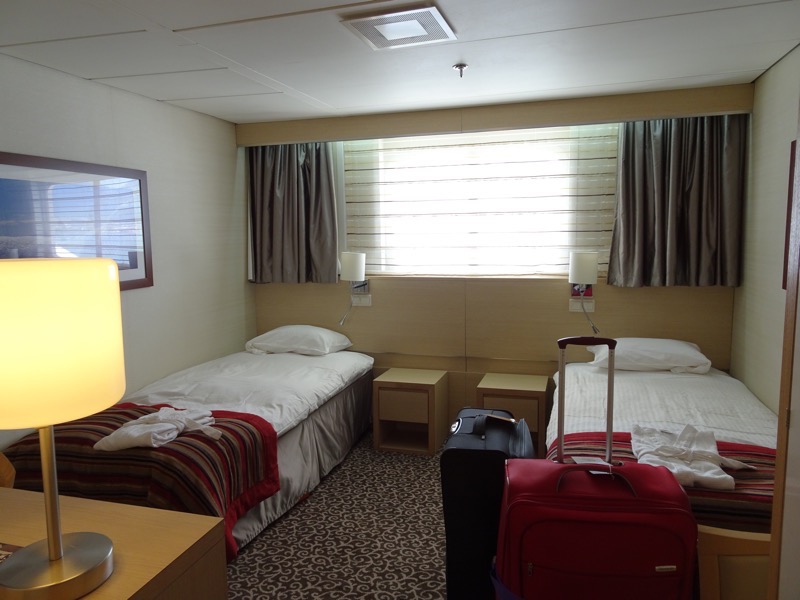
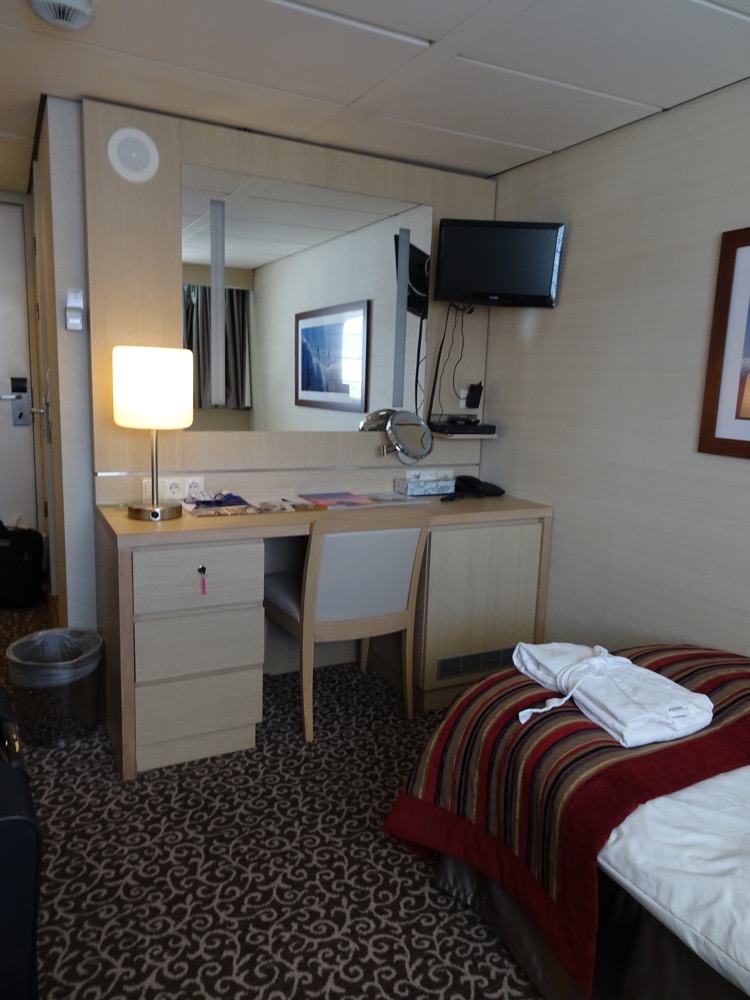
Quark Clothing – Parka and Boots
One of the first things the staff did for us was to outfit us with our Expedition parkas, which have been specially designed by Quark for Quark passengers for Antarctic and Arctic Expeditions. They are big and bulky, with loads of pockets to hold your excess things, but they are super warm and I have found myself wearingly only a thin merino thermal layer, a long-sleeved t-shirt layer and the parka. No need for a jumper or polar fleece layer at all. Aside from being a butt-ugly bright banana yellow, they are an excellent item of clothing and have obviously evolved from years of feedback and from passengers being unprepared for the conditions here.
Over the top of all this, you will find yourself wearing your PFD (personal floatation device) every day when you are off the ship. You must wear it on the zodiacs and you will find yourself wearing it while walking around on land because wearing it is easier than carrying it. It’s a fairly slim design as life jackets go, but it’s fairly heavy and rather bulky on the back of your neck and chest. You end up walking everywhere feeling like the Michelin Man.
The Muck Boots that are lent to passengers to use while they are on their expedition are also another very sturdy and solid piece of equipment that is absolutely essential. There is a major downside to the boots being provided on the ship though… they’re men’s boots. All of them. So ladies are being given whatever size is appropriate for their feet. In my case, I wear a ladies size AU 6 (or EU36-37) and in a men’s boot – say in Dr Marten boots – I wear a men’s size 4. Only problem is, women’s legs tend to be far more shapely than shoes made for men’s legs – men’s size 4 boot is effectively made for a ten year old boy with chicken legs. So I had to go a size up and wear a size 5, and even that was far too tight in the calves that I had to fold the boots down, rendering them less useful as waterproof boots when getting in and out of the zodiacs at landing sites. After the first day though, it rapidly became apparent that the size 5 boots, even with the height of them folded down on themselves was no good – as it was still so tight around my upper ankle that it was cutting off the circulation in my foot and starting to bruise my shin! So I had to go back and get a men’s size 6 boot. I am still wearing them folded down and even with two pairs of sole inserts in each boot, I feel like I am clambouring about in clown shoes. My feet are slipping about all over the place inside my boots and I have been ever so slighting twisting my knees every day – not good. I’ve also had to be extra careful on the rocks and ice when ashore to make sure I don’t lose my footing in these boots that are two sizes too big – they’re quite the trip hazard. So if you know you have a tiny foot and muscular calves… I’d seriously consider trying to bring your own good quality insulated waterproof boots from home. They might be expensive and may never get used much again in the future, but the stability and sureness underfoot would be worth it.
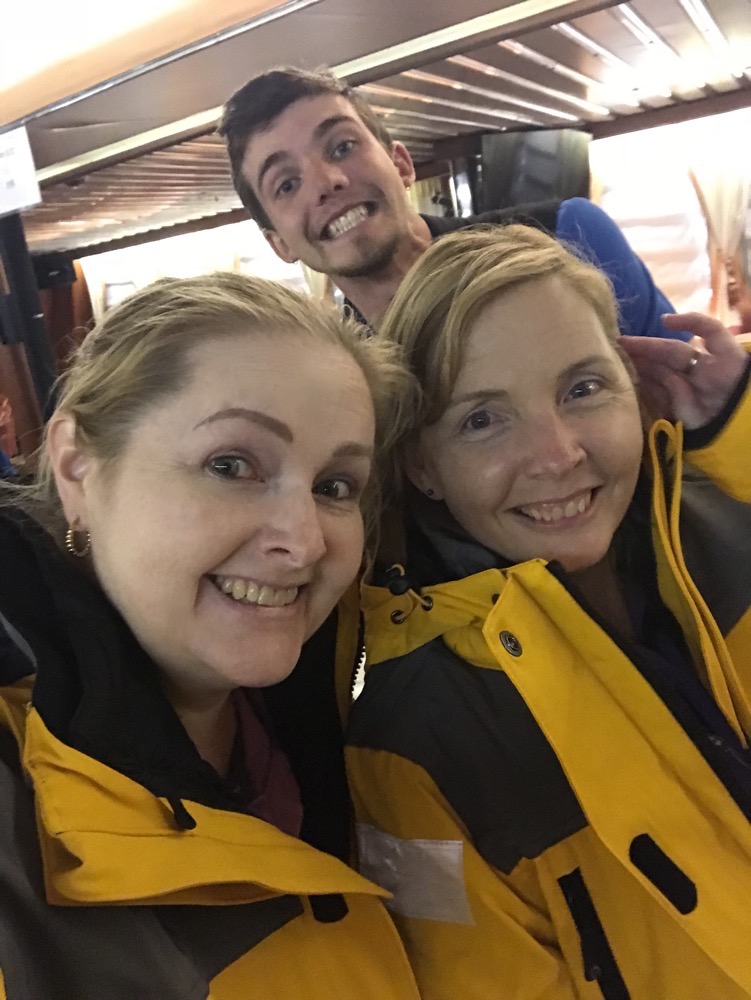
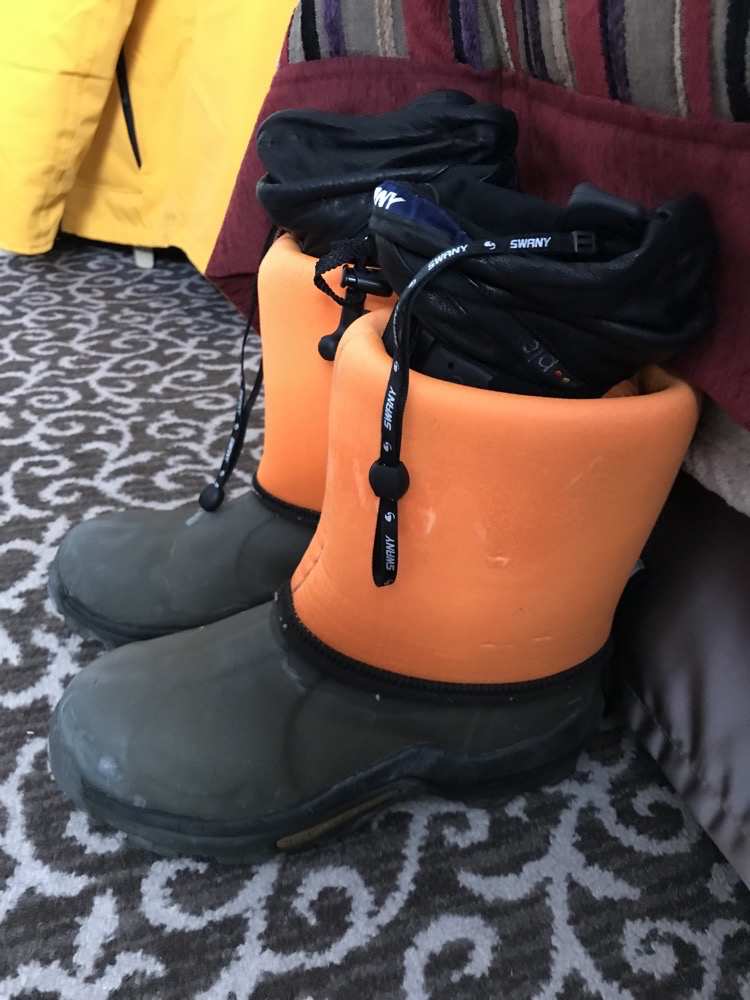
Food
The food has been amazing on board, with a wonderful variety and plenty of it!
An enormous buffet breakfast is served at approximately 0730-0830 in the main dining room and there are plenty of options from various breads, cereals, cold meats, smoked salmon, cheeses, eggs, bacon, sausages, hash browns, baked beans, a couple of omelette stations, tea, coffee, juices, yoghurts – the whole shebang.
Lunch is again served buffet style between 1230 and 1330 (depending on how morning land and zodiac excursions have gone). There is usually a pasta or stir-fry stations, plenty of salads and cold meats, and hot dishes that vary every day which usually include some grilled fish, and some sort of casserole option with vegetables, rice or pasta to compliment. Soups are also available at lunch, with breads, and desserts also on offer. There is a daily a la carte sandwich, hamburgers and other things available on request and the dining team do their best to help provide options for people with dietary requirements. There is also a new refreshing non-alcoholic punch to try every day.
Dinner is served in the main dining room starting from 1900-1930 after the evening debrief/recap. Dinner is a four course table service menu with appetizers and salads, a soup course (usually a choice of two soups), a main meal course (usually a fish, beef/pork option and a chicken option) followed by a desserts (usually a specialty dessert, an ice cream sundae type option, a cheese platter or a selection of fruits). Dinner is served with complimentary red or white wine – often sauvignon blanc or cabernet blends from Argentina to Italy to New Zealand. For those that don’t favour wine, beer and soft drinks and juices are also available. We are used to a cup of tea or coffee being served at the end of a meal, but for that, we needed to go to the Club to make our own.
Seating in the dining room is strictly first-come first-served, there is no reserved seating and no allocated table numbers. One of the best aspects of dining on the ship is that members of the Expedition Team will come and join a different table for dinner each night – a more interesting and well-travelled and sociable bunch you will never find. So our dinner conversations have all been very lively and inspiring.
Internet
I could find ZERO information on Internet availability or cost prior to actually getting on the ship – even the Expedition staff who briefed us in Ushuaia were cagey about the accessibility once onboard, which is a bit shit or I would have told my family not to expect to hear from me at all for the next 14 days.
Further to that, there is considerable pressure from the Expedition Team who will encourage you to ‘disconnect’ and discover this amazing place as the first explorers would have – without the ability to connect back to The Real World™. Additionally, your fellow passengers will also loudly and proudly exclaim on the first day or so that they are going to completely disconnect for the duration as well, so there is considerable peer pressure to leave the Internet alone too. Given that the Internet on the ship completely sucks balls, in both speed and expense, as well as actual availability – there doesn’t appear to be many people actually using it.
There are three packages available:
- USD$35 Webmail Package : they will set you up a text only email address for use while you are on the ship.
- USD$60 Package: Internet access of 60MB of data. Untimed but limited by data usage.
- USD$100 Package: Internet access of 200MB of data. Untimed but limited by data usage.
None of these packages are suitable for blogging or sending lots of pictures back home but still, they might be all fine and dandy if you were 100% confident that you have NOTHING running in the background of your smartphone or iPad or laptop that was going to be refreshing or downloading or synching stuff while you were carefully trying not to use your data. It would be all too easy to jump online to chat a bit via WhatsAp or Messenger and then check your limit and find out it’s been all chewed up by something you didn’t know was running. I have decided not to buy an internet package but I have a feeling I am going to really regret that by the time we are on the Drake Passage on the homeward stretch.
Photo Journal
The on-board photographer who is here to give you hints and tips on how to best capture your Antarctic experience also sets up a couple of laptops on the ship and encourages passengers to share photographs. These photographs will be available to all of us at the end of the trip.
What often seems to happen with wildlife photography and when we are out in the zodiacs in particular, is that half the people on the small boats will have a great view of a particularly exciting wildlife moment and the other half of us will end up with a row of yellow jackets, or someone else’s camera protruding into our shot, or just a blurry mess as you spin around onto your knees to allow others to see. So we all get to view these amazing things, but only about half of us have the good fortune to capture those special moments of a whale breaching or of a leopard seal hurling it’s catch – so the photo journal is a really good idea and many people will participate in sharing their images. So long as you are not a professional photographer planning on making a commercial enterprise out of your photographs, I would strongly encourage people to share their best shots so we can all come away with beautiful images of our shared experiences regardless of where your seat is on the zodiac that day.
The images get compiled and are made available to passengers via a Quark website where you can go to download them once you are home. Worth noting is that the downloadable images will be in a slightly lower resolution than that which was provided by your fellow passengers. Also worth noting – once you put your images into the Photo Journal you are basically giving them to Quark; to potentially use in their advertising brochures and online web presence. While the Photo Journal is a great resource for the passengers and is a fantastic idea for sharing your best pictures with your fellow travellers, Quark are very happily collecting amazing images for free – which doesn’t bother me, but maybe a concern for some.
Laundry
Halfway through our journey, a ‘special’ for an entire bag of laundry for USD$30 was offered to us, which we took full advantage of. The laundry bag is very generously sized if you wanted to wash jumpers or polar fleece items. The laundry list was amusing – there are pantyhose and stockings listed on the items that you may want laundered, and we couldn’t help but wonder who on earth is coming down here with pantyhose and ladies shoes!
Had we known this laundry offer would come around about mid-trip, we could probably have gotten away with a one week pack instead of packing enough clothing for two weeks – having said that nearly everyone here is wearing the same things to shore every day, and the same things to dinner every night, so it is not like a traditional cruise in that respect! Walking pants or even track pants in the dining room are passable attire.
Giftshop
There is a gift shop onboard that carries a limited range of Antarctic souvenirs, but they do have a good range of warm clothing if you find you don’t have enough layers or need a second beanie or something. I have noticed though that most of the items seem to circulate through a discount table or rack at some point – this could be because we are at the end of the season and they are trying to get rid of stock, or it could just be the way the gift shop always runs… but I’d avoid paying full price on any of the clothing items for the first few days and wait to see if any discount tables appear. The store manager also appears to have considerable discretion to discount items too.
As it happens, there is often an opportunity to send postcards from one from one of the stations along the Peninsula here. Now I haven’t sent postcards home for years, but we are in Antarctica and I’m kinda curious how long it will take, so why not? We were given about 30 minutes warning before going ashore that we would be able to send postcards at that day’s landing, so as you can imagine everyone was scrambling for the gift shop to pick up some cards – which unfortunately had heaps of cards with images of South Georgia and the Falklands and the Southern Oceans, but not many that actually had images of Antarctica or that said, ‘Antarctica’. So I’d advise getting i early and buying some postcards that say ‘Antarctica’ if you are planning on trying to send some home for fun – or better yet, pick some up in Ushuaia on spec.
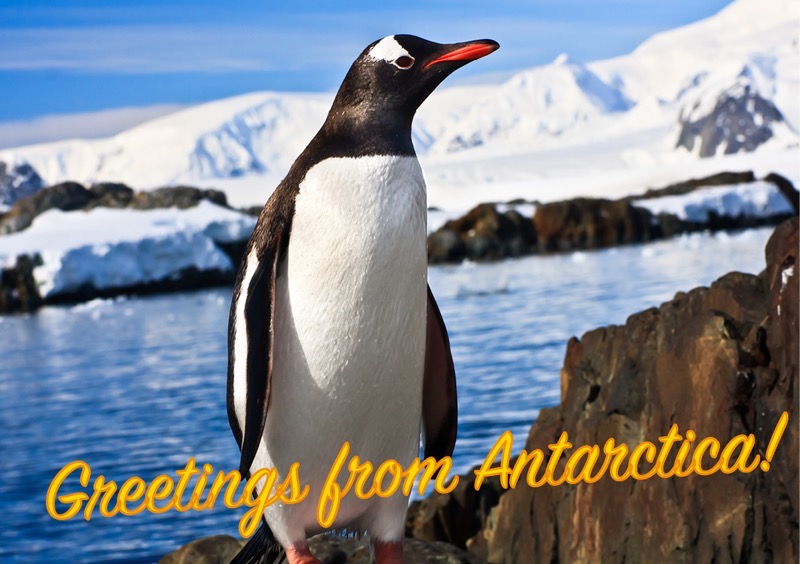
Things I’m really glad I brought with me…
Merino neck warmer – I bought a cosy neck warmer at a ski shop in Whistler for about $30. So far it has proved a great investment on the zodiac cruising as you can pull it up over your face and to cover your ears when it’s cold, and it’s a lot easier to wrestle with than a scarf.
Toe warmers – we happened to pick up bulk bags of toe warmers when we were in Canada in January, and they were $9.99 for a pack of 16 pairs of toe warmers… here on board and in Ushuaia (and indeed back home in Brisbane) they are selling for about $3.00 a pair. So bulk toe warmers from Amazon or something is not a bad plan, they’re good and they really help when you are sitting still in the zodiacs for what can seem like quite a long time if you are cold. They are also useful to put in your mittens or pockets – or even attach them to electronic devices if the batteries don’t like extreme cold.
Laptop – every day we are out on the zodiacs and every day I’ve been worried about dropping my camera overboard. I have it tied to my wrist with a lanyard, so it’s unlikely, but I’m sure it happens to someone. Anyway, I’m glad I brought my laptop as I’ve been backing up my photos after every excursion – so if the camera goes over, I’ll only lose a handful of pictures, not the lot. Also, I’ve been able to write this blog even though I’m offline… which is good or I’d be so far behind I’d never catch up.
Teabags – weird as it sounds, English Breakfast tea is often thin on the ground. It’s popular as all giddy-up so it gets used up quickly and on ships sometimes seems to run out. The weird orange, chamomile, or apple cinnamon flavoured teas will still be around for the whole trip but good old English Breakfast tea bags will disappear. So I always pack a little bag – back up tea bags, raw sugar, hot chocolate sachets, chai lattes and even mushroom cup-a-soups. They don’t weigh much but can make life more pleasant – which probably says a lot about the type of traveller I am 😉
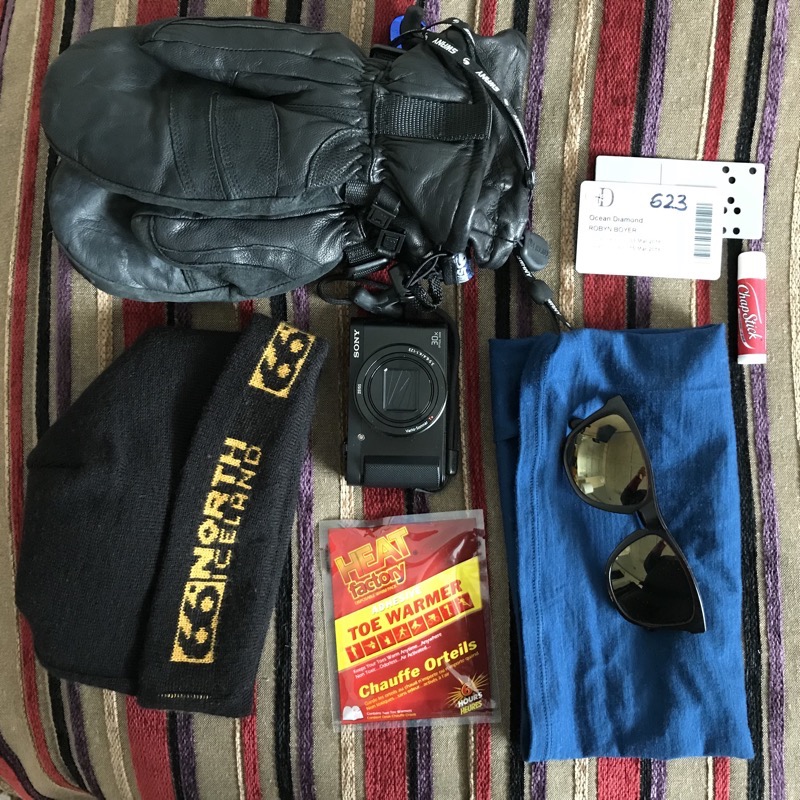
Things I wish I had brought with me…
A travel mug – there is no tea or coffee in our rooms and no room service, so to get a cuppa we need to go down to the tea and coffee station on Deck 4 and then carry it up four small flights of stairs to Deck 6. Not such a big deal, except when the ship is rocking or if there are plenty of people about. A covered travel mug would have been a good addition to my pack.
A crazy/unusual hat – even a bandana would do. It is apparently a tradition to hold an alfresco dining evening at some point throughout the expedition (weather permitting) and everyone is encouraged to wear a crazy hat. Come to think of it every cruise I’ve been on has a ‘mad hatters’ lunch or afternoon tea or something, so I probably should have been all over this one. Instead, passengers were encouraged to get resourceful and create a fun and crazy hat from found objects around the ship. Mind you, you never seem to have a lot of spare time, so making some piece of creative headgear is not so easy.
A USB stick – I usually travel with one, but for some reason, I forgot to bring one on this trip. I mentioned earlier, the Photo Journal where people can share images they are happy to have disseminated to all passengers… if there is any particular photo you absolutely love in the ‘Photo of the Day’ or you hear people talking about someone or other’s great leopard seal feeding pic, you can copy it from the laptops during the trip to get the high-resolution version, rather than wait for the resized downloadable content. A USB is also useful to share bulk pictures or videos directly with other people you meet on the ship.
Chocolate – the Expedition Staff usually only have a few hours in town during turn around days and they tend to use that time to find free wifi spots to catch up with family and friends. It turns out that one of the only food staples that they tend to run out of is chocolate. So if you’d like to make immediate friends with the expedition staff – bring lots of chocolate to bribe your way into their good books. 😉
Things I should have left behind…
Snacks – we brought a few snack foods on board, including cheese and crackers, because we know that the cheese and crackers thing isn’t really an Argentinian thing or an America thing for that matter. Many times I have walked into American supermarkets looking for the makings of a decent cheese plate, and found the options are severely limited. You just can’t find good charcuterie, pates, dips, and fancy cheeses in regular supermarkets the way you can in Australia. So we brought some of these sorts of snacks on board. What we hadn’t counted on was, Gunter – our Austrian Executive Chef on board, who has the cheese and crackers and savoury snacks thing absolutely nailed down… an entire wheel of Roquefort stationed at every buffet meal; happy thought indeed.
Walking poles – One of our party brought a walking pole with her as she has long-term knee problems, and we were anticipating crossing rocky and icy terrain when ashore. Quark provides walking poles at every landing site, so you can use theirs and not have to worry about bringing yours and putting it through the biosecurity cleaning processes.
If you happen to be reading this because you’ve stumbled on it while searching about doing a Quark Expedition and you have any questions that I might be able to provide insight on – just ask in the comments and I will do my best to answer.

Wow – this was super helpful! We’re on Quark’s Fly the Drake trip, Dec. 13-20 and I just got a ton of info from your blog about what to bring/leave behind. Thanks!
How was your trip Katy?
Right before Covid shutting down all our travel.